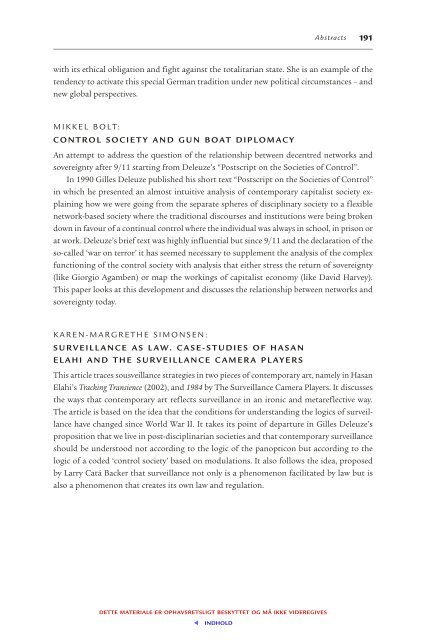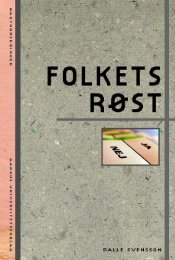K&K. Kultur og Klasse · Nr. 110 · Årgang 2010 - Aarhus University ...
K&K. Kultur og Klasse · Nr. 110 · Årgang 2010 - Aarhus University ...
K&K. Kultur og Klasse · Nr. 110 · Årgang 2010 - Aarhus University ...
You also want an ePaper? Increase the reach of your titles
YUMPU automatically turns print PDFs into web optimized ePapers that Google loves.
DETTE MATERIALE ER OPHAVSRETSLIGT BESKYTTET OG MÅ IKKE VIDEREGIVES<br />
INDHOLD<br />
Abstracts<br />
with its ethical obligation and fight against the totalitarian state. She is an example of the<br />
tendency to activate this special German tradition under new political circumstances – and<br />
new global perspectives.<br />
MIKKEL BOLT:<br />
CONTROL SOCIETY AND GUN BOAT DIPLOMACY<br />
An attempt to address the question of the relationship between decentred networks and<br />
sovereignty after 9/11 starting from Deleuze’s “Postscript on the Societies of Control”.<br />
In 1990 Gilles Deleuze published his short text “Postscript on the Societies of Control”<br />
in which he presented an almost intuitive analysis of contemporary capitalist society explaining<br />
how we were going from the separate spheres of disciplinary society to a flexible<br />
network-based society where the traditional discourses and institutions were being broken<br />
down in favour of a continual control where the individual was always in school, in prison or<br />
at work. Deleuze’s brief text was highly influential but since 9/11 and the declaration of the<br />
so-called ‘war on terror’ it has seemed necessary to supplement the analysis of the complex<br />
functioning of the control society with analysis that either stress the return of sovereignty<br />
(like Giorgio Agamben) or map the workings of capitalist economy (like David Harvey).<br />
This paper looks at this development and discusses the relationship between networks and<br />
sovereignty today.<br />
KAREN-MARGRETHE SIMONSEN:<br />
SURVEILLANCE AS LAW. CASE-STUDIES OF HASAN<br />
ELAHI AND THE SURVEILLANCE CAMERA PLAYERS<br />
This article traces sousveillance strategies in two pieces of contemporary art, namely in Hasan<br />
Elahi’s Tracking Transience (2002), and 1984 by The Surveillance Camera Players. It discusses<br />
the ways that contemporary art reflects surveillance in an ironic and metareflective way.<br />
The article is based on the idea that the conditions for understanding the l<strong>og</strong>ics of surveillance<br />
have changed since World War II. It takes its point of departure in Gilles Deleuze’s<br />
proposition that we live in post-disciplinarian societies and that contemporary surveillance<br />
should be understood not according to the l<strong>og</strong>ic of the panopticon but according to the<br />
l<strong>og</strong>ic of a coded ‘control society’ based on modulations. It also follows the idea, proposed<br />
by Larry Catá Backer that surveillance not only is a phenomenon facilitated by law but is<br />
also a phenomenon that creates its own law and regulation.<br />
191








